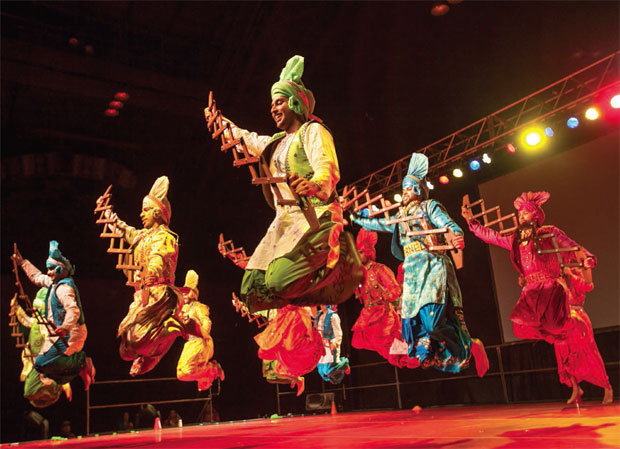For ninety seconds, the eyes of millions were on Cornell Bhangra. The student dance team had earned a coveted slot on “America’s Got Talent,” and its members were determined to make the most of their mid-August performance at Radio City Music Hall.
Six pairs of dancers clad in elaborate, brightly colored costumes moved to a fusion of hip-hop rhythms and Indian melodies. Halfway through the routine, another dancer leapt out of the audience and joined the rest onstage—their swirling, kaleidoscopic performance earning rousing applause. Though the group didn’t advance to the next round, its members were thrilled to have made it that far. “It was a crazy journey, and we were blessed to represent not just our school, but also our culture,” says co-captain Armaan Kapoor ’15, a Hotelie. “It was amazing to be able to bring India’s culture to the mainstream.”

Poetry in motion: Cornell Bhangra leaps into action in Barton Hall.
Founded in 1997, Cornell’s squad is one of America’s bestknown bhangra dance teams, with two championships in the World’s Best Bhangra Crew Competition to its credit. Each spring, the group hosts Pao Bhangra: The Bhangra Olympics, the largest student-run event at Cornell. The biggest bhangra exhibition in the country, it usually sells out Barton Hall and draws thousands of spectators. The team also tours North America, with performances in Boston, Buffalo, Pittsburgh, Philadelphia, Toronto, Vancouver, and California in recent years, as well as a September appearance at Jazz at Lincoln Center for the launch of Cornell’s Sesquicentennial celebration.
Bhangra means “to be intoxicated with joy”—an appropriate description of the folk dance from the Punjab region in northern India. “It’s a very upbeat style of dance,” Kapoor says, “and it matches extremely well with hip-hop and pop music.” Traditionally, bhangra is performed at annual harvest festivals in Punjab, which influences some of the moves. Arms and hands flow to represent crops swaying in the wind; the festivals’ fireworks inspire some of bhangra’s explosive footwork and hand movements. The dancers also use props such as a sapp, a small wooden device that is collapsed and expanded to the beat of the music. “Bhangra is a fun, powerful dance with a lot of culture and meaning behind it,” says human development major Ashley George ’16, who adds, “Part of the reason I joined was because of how strongly the team stresses that girls and guys dance at the same level of intensity—something that very few styles of dance share.”
Cornell Bhangra attracts a variety of students, many of Indian descent but some who are not. Performing and media arts major Darah Barnes ’15, who is African American, has been on the team since freshman year. “For me, the most challenging thing about bhangra was getting the cultural, stylistic elements down,” she says. “At its most basic form, bhangra is just a lot of stepping and skipping—but the Punjabi flavor is what makes it so cool.”
Cornell Bhangra first auditioned for “America’s Got Talent” last spring; it advanced to the next round, but had to withdraw because performance dates conflicted with finals. But in June, the team was invited to perform in a talent competition on the “Today” show. Its Rockefeller Plaza routine won the popular vote, propelling it to the “America’s Got Talent” quarterfinals. That performance can be seen on YouTube, where it has had more than 250,000 views. “When it comes down to it,” Kapoor says, “that was the most memorable minute and a half of my life.”
Back on campus, Cornell Bhangra aims to continue its momentum into the school year. The group hosts the largest dance tryouts on campus: nearly 200 students auditioned in September, with twelve new members rounding out the twenty-eight-person roster for this year. “Our team really is a family,” George says. “As important as competing is, we never let it sour our interpersonal relationships. At the end of the day, we’re celebrating our love for our culture and dance. Whether or not we place at a competition doesn’t change that.”


